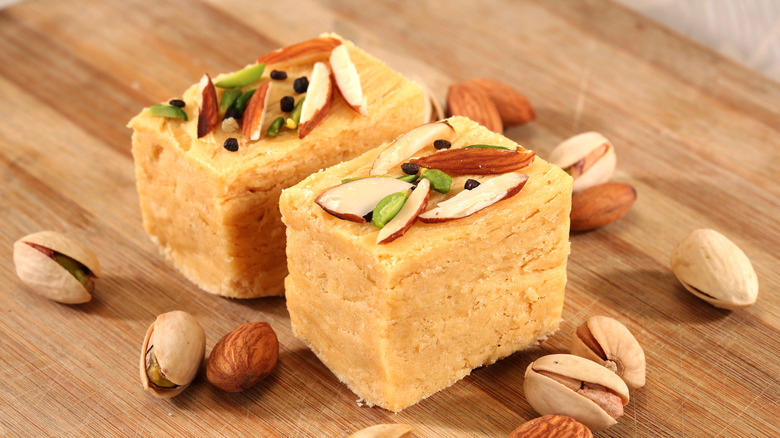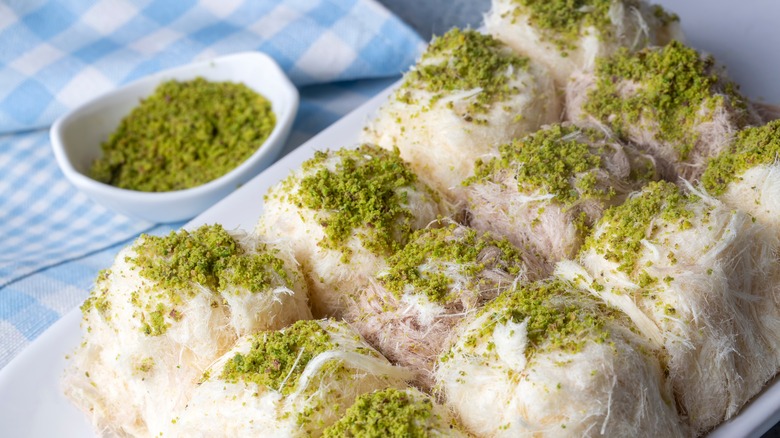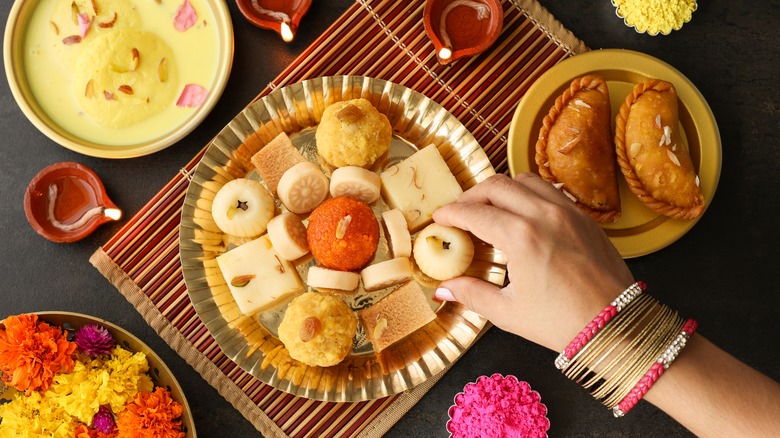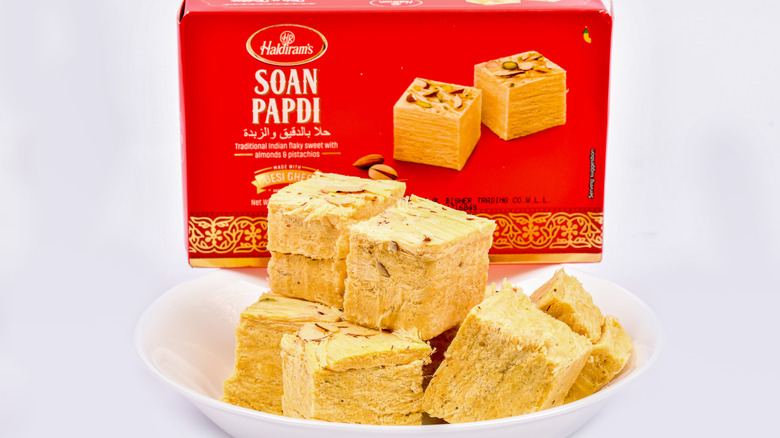Soan Papdi: The Simple Indian Sweet That's Everywhere During Diwali
Every major holiday has its own specialty treats. For example, during Christmas, Americans bake gingerbread cookies; during the Día de Los Muertos, those of Mexican heritage cook up sugar skulls (which are not to be eaten) and Pan de Muerto, and Jewish people make apple cakes to celebrate Rosh Hashanah. We carry our cultural traditions with us through the foods we eat, and many of us take great pride in the recipes and traditions we partake in during celebrations. In India, one of those traditional recipes is soan papdi.
The India Times claims that soan papdi is a well-established Diwali dessert with no confirmed origin. It is also known as patisa, san papri, or shonpapdi, and while it is super popular in India around the holidays, versions of this sweet are eaten worldwide. Soan papdi tends to come in golden brown color, is often presented in square or rectangular shapes, and is sometimes studded on top with nuts and dried berries.
How is it made?
Soan papdi is a traditional Indian dessert closely related to the Turkish sweet pişmaniye. According to The Food Hog, pişmaniye is made by forming a fine floss out of flour, butter, and sugar. Soan papdi is made much in the same way, says Awesome Cuisine, though pişmaniye traditionally has a strong nutty flavor, whereas the Indian treat is lighter. It is often cut into cubes and flavored with sugar, cardamom, pistachios, or almonds and is crisper and flakier than the more cotton candy-like pişmaniye.
The Times Food says that while soan papdi can be bought at any old Hindu grocery store, it can also be easily made using some of the most basic ingredients you probably have at home. The process of making this classic Indian treat begins by gathering gram and all-purpose flour, ghee (clarified butter), sugar, milk, and cardamom. Simple, right?
Add the ghee to a saucepan, and mix your flour into the butter until the sauce is golden in color. Set that aside to cool, and then heat your sugar into a syrup with water and milk. When the syrup is completed, pour it into the four mixture and whisk until flaky. Finally, add the cardamom and shape or decorate however you like! The simplicity of this sweet is one of the reasons it is so popular to see during Diwali.
Soan papdi is a Diwali staple
Before discussing why soan papdi is a staple during Diwali, it is important to understand what Diwali is. National Geographic describes Diwali, or Dipawali, as a festival of lights that is celebrated throughout India and by Hindu practitioners worldwide for five days straight. On the first and second days, homes are cleaned and decorated with rangoli designs which look like a blooming flower, and gold is bought to symbolize good fortune. Day three is when families come together for Lakshmi puja (a special prayer), feasts, and fireworks. The next day is the beginning of the new year, and the final and fifth day is when the family visits and shares a meal. It is an extravagant time of year full of love, laughter, color, and lots and lots of food.
Sweets are particularly popular during this time of year. People consume dishes such as jalebi, karanji, gulab jamun, rasgulla, and coconut burfi, via Swasthi's Recipes, but one Diwali dessert that everyone has to have is soan papdi. The Indian Express tells us that this particular dessert is popular during the celebration because it is versatile and has a long shelf life due to all the sugar in it. Because it keeps so well, it is the perfect sweet to offer to a deity at the altar or to store in the pantry for a long time. You don't want your offerings or holiday cheer spoiling quickly.
Why is social media memeing soan papdi?
This year's Diwali began on Saturday, October 22, and it will end on Wednesday, October 26, with the height of the celebration landing on October 24. People preparing to celebrate have already taken to the internet to joke around and share in the holiday fun (via ABC News). However, recently, NDTV Food has reported that soan papdi has started to make headlines! Memes and personal commentary have begun to flood the internet regarding a humorous aspect of the Diwali dish that is apparently a universal experience for those celebrating the holiday.
Twitter user @abhi_lekh_ said it best when they posted, "Soan papdi is the original cryptocurrency. No utility, only gift-giving value, and you can never tell who the original owner is," in reference to how everyone seems to be giving the treat as their Diwali gift, yet no one really wants it. It seems like the sweet is treated much like fruitcake during Christmas, where it is traditionally gifted, but it is more likely to be re-gifted and passed from one gift-giver to another (via Holiday Insights). The jokes are never-ending, and if you're looking for a big laugh, try searching Twitter for soan papdi; you'll get a good kick out of it!



